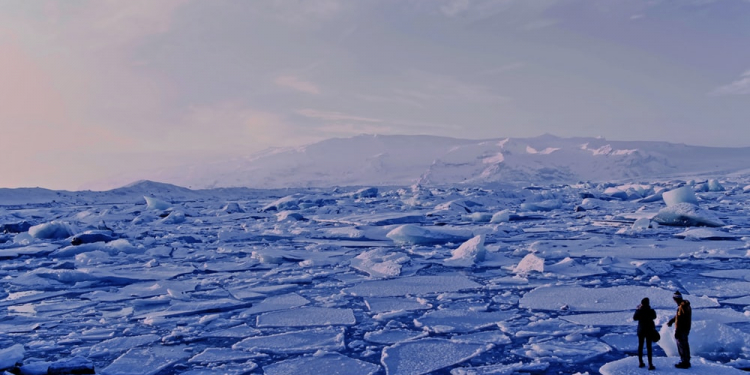When glacial ice sheets melt, something counterintuitive happens to sea levels. Logic might suggest that nearby levels would rise, but instead they fall. Thousands of miles away, however, they do go up in a kind of seesaw effect. Why? The answer is that water disperses away owing to the loss of gravitational pull toward the ice sheet.
The patterns of how that happens are called sea level fingerprints, since each incidence is unique. Elements of the concept — which lies at the heart of the understanding that global sea levels don’t rise uniformly — have been around for more than a century, and modern sea level science has been built around it. But there’s long been a knowledge gap in the widely accepted theory. A sea level fingerprint has never definitively been detected by researchers.
A team of scientists — led by Harvard alumna Sophie Coulson and including Harvard geophysicist Jerry X. Mitrovica — believe they have detected the first. The findings are described in a new study published Thursday in Science. The work validates almost a century of sea level science and helps solidify confidence in models predicting future changes, projections that have grown more important on the warming planet.
“In sea level physics, almost everyone assumed that the fingerprints existed, but they had never been detected at a comparable level of confidence.”
— Jerry X. Mitrovica, Harvard geophysicist
“Ocean level projections, urban and coastal planning — all of it — has been built on the idea of fingerprints,” said Mitrovica, the Frank B. Baird Jr. Professor of Science in the Department of Earth and Planetary Sciences. “That’s why fingerprints are so important. They allow you to estimate what the geometry of the sea level changes is going to be like … so we now have much more confidence in how sea level changes are going to evolve. … If fingerprint physics wasn’t correct, then we’d have to rethink all modern sea level research.”
Sea level fingerprints have been notoriously difficult to track because of the major fluctuations in ocean levels brought on by changing tides, currents, and winds. That presents researchers with the challenge of trying to detect millimeter level motions of the water and link them to melting glaciers thousands of miles away.
Mitrovica compared the search to the one for the subatomic particle the Higgs boson.
“Almost all physicists thought that the Higgs existed, but it was nevertheless a transformative accomplishment when it was firmly detected,” Mitrovica said. “In sea level physics, almost everyone assumed that the fingerprints existed, but they had never been detected at a comparable level of confidence.”
When glacial ice sheets melt, something counterintuitive happens to sea levels. Logic might suggest that nearby levels would rise, but instead they fall. Thousands of miles away, however, they do go up in a kind of seesaw effect. Why? The answer is that water disperses away owing to the loss of gravitational pull toward the ice sheet.
The patterns of how that happens are called sea level fingerprints, since each incidence is unique. Elements of the concept — which lies at the heart of the understanding that global sea levels don’t rise uniformly — have been around for more than a century, and modern sea level science has been built around it. But there’s long been a knowledge gap in the widely accepted theory. A sea level fingerprint has never definitively been detected by researchers.
A team of scientists — led by Harvard alumna Sophie Coulson and including Harvard geophysicist Jerry X. Mitrovica — believe they have detected the first. The findings are described in a new study published Thursday in Science. The work validates almost a century of sea level science and helps solidify confidence in models predicting future changes, projections that have grown more important on the warming planet.
“In sea level physics, almost everyone assumed that the fingerprints existed, but they had never been detected at a comparable level of confidence.”
— Jerry X. Mitrovica, Harvard geophysicist
“Ocean level projections, urban and coastal planning — all of it — has been built on the idea of fingerprints,” said Mitrovica, the Frank B. Baird Jr. Professor of Science in the Department of Earth and Planetary Sciences. “That’s why fingerprints are so important. They allow you to estimate what the geometry of the sea level changes is going to be like … so we now have much more confidence in how sea level changes are going to evolve. … If fingerprint physics wasn’t correct, then we’d have to rethink all modern sea level research.”
Sea level fingerprints have been notoriously difficult to track because of the major fluctuations in ocean levels brought on by changing tides, currents, and winds. That presents researchers with the challenge of trying to detect millimeter level motions of the water and link them to melting glaciers thousands of miles away.
Mitrovica compared the search to the one for the subatomic particle the Higgs boson.
“Almost all physicists thought that the Higgs existed, but it was nevertheless a transformative accomplishment when it was firmly detected,” Mitrovica said. “In sea level physics, almost everyone assumed that the fingerprints existed, but they had never been detected at a comparable level of confidence.”
BY Juan Siliezar





























Discussion about this post